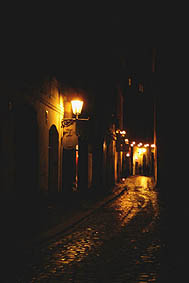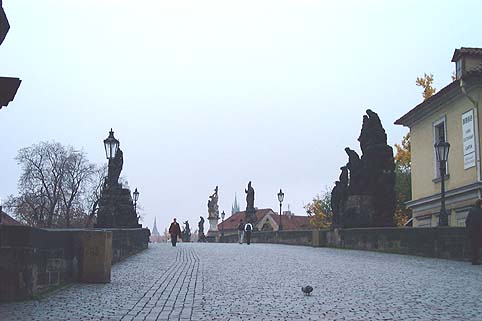|
Charles IV put on his shoes made of straw and began his walk from Prague Castle to Vysehrad, the crown of the Bohemian Kingdom resting firmly on his head. Regardless of the theatrics, or maybe also because of them, Charles IV had an immensely successful reign. He founded Nove Mesto (New Town) and the Charles University, laid the foundations of the Sv. Vit (St. Vitus) Cathedral and the Charles Bridge and carried out many other civic improvements. This walk will follow Charles's and his successors' steps on the King's Road. |
We start at the Old Town Square, which was always a very important stop. And from there we continue to Male namesti (Small Square), into Karlova (Charles Street) and over the Charles Bridge (Karluv most). In the Mala strana (Lesser Quarter) the route goes through Mostecka (Bridge Street) over Malostranske namesti (Lesser Quarter Square) and up the hill by what is now called Nerudova and Ke Hradu towards the front gate of the Prague Castle.
|
In the middle ages, Male namesti was a fruit and vegetable market and the triangular square now surrounds a well dating to 1560 that is decorated with superb ironwork and topped by a gilded Lion of Bohemia. Many houses in the area still have Romanesque cellars. The Rott House, which now has a neo-Renaissance facade, served as an ironworks shop until recently. Once it was owned by the printer Jan Pytlik, who in 1488 published the first Bible in Czech. Continuing along the coronation route in the narrow Karlova, the street soon meets Husova. A few short steps off the route to the left is the Golden Tiger, a pub where the Czech novelist Bohumil Hrabal had a beer with the American president Bill Clinton. The golden Tiger was also frequently visited by Czech dissidents in the seventies and eighties. Around the corner in Retezova is the recently reopened cafe Montmartre, haunt of artists before the WWI.
Back along Husova is the Clam-Gallas Palace. Designed by a Viennese architect, the building is one of his most important contributions to Prague. On the corner of Karlova and Seminarska is the House of the Golden Well; saints were placed on its Baroque facade after the outbreak of the plaque in the early 1700s. Further down, on the corner of Liliova, is the house of the Blue Pike. In 1907, the building housed Prague's first cinema. The House of the Golden |
 |
Serpent, where an Armenian merchant opened Prague's first coffee house, is right across the street. The Renaissance House of the Crown of France, Karlova 4, is where Johannes Kepler lived and researched the physical laws that he later published in the New Astronomy. The Italian Chapel on the other side of Karlova is where these artists attended mass. The Church of Saint Clement, next door to the chapel, was taken over by the Jesuits from the Dominican order when they first arrived in Prague. The Church of the Savior, on the other side of the chapel, was founded by the Jesuits in the late 1500s.
In 1556, the Habsburg Emperor called in the newly formed Jesuit order to Prague to strengthen the Catholic faith in Bohemia. The Jesuits were given a large area in the Old Town to build a university, libraries and other educational facilities to compete with the Charles University. The Clementinum now houses the National Library, comprising several million books, including rare medieval manuscripts. Hidden away behind high walls, the Clementinum is larger in land area than Old Town Square and quite a contrast to the busy winding streets of Old Town. Upriver, on a pier just past the bridge, are Charles's Baths. At the end of the pier is a museum dedicated to Bedrich Smetana, in a neo-Renaissance building that used to be the Old Town Waterworks. |
 |
|
Krizovnicke namesti (Square of the Knights of the Red Cross) is named after a hospice brotherhood (the Church of St. Francis is where their monastery used to stand) that collected tolls on the Judith Bridge. This bridge ran parallel to the course of the present Charles Bridge until high water swept it away and flooded the Old Town in 1342. Foundations of the Charles Bridge were laid fifteen years later, but this new sandstone bridge was not completed until 1402. These days a major reconstruction is consider, starting spring 2002. |
As we enter the Charles Bridge we will pass through the Bridge Tower. The riverside facade of the tower on the Old Town side was severely damaged during Swedish shelling at the end of the Thirty Years' War, but the eastern side of the tower has copies of the original decorations. The Gothic masterpiece was built by Petr Parler, who also supervised the construction of the new bridge.
|
|
Thirty sculptures of saints line the Charles Bridge. A Calvary near the Old Town side carries gold lettering in Hebrew: Holy, Holy, Holy God. It was placed there after a Jew allegedly debased the Christian faith and had to atone for his trespass by paying for the sign. Closer to Mala Strana stands St. John of Nepomuk; touching the statue us said to fulfill one's wishes. St. Nepomuk, confessor to the queen, refused to violate his vow of silence and the enraged king had the priest tortured and thrown off the Charles Bridge into Vltava, where he drowned. On the left, off the bridge on Mala Strana, is a statue of Brunswick. Continue to Malostranske namesti. |
|
When you get to the Malostranske namesti, enter St. Nicholas from the top of the square. The church is hard to miss, as it dominates the square. Built for the Jesuit Order by the Dientzenhofer family between 1703 and 1752, it is simply overhelming- inside and out. A tale about the ceiling fresco has it that the painter did not want anyone to see his work until he had finished. An impatient Jesuit novice sneaked into the churh ,hid behind a pillar and watched the painting in progress. The artist, however, spotted the Jesuit in a small mirror. When the fresco was unveiled, the other novices immediately recognised him portrayed in the work as a poor fisherman and the Jesuit became a laughing- stock for all time. |
|
